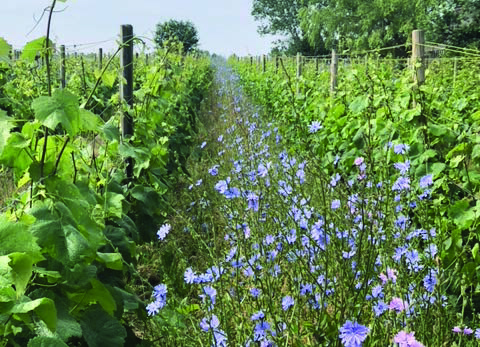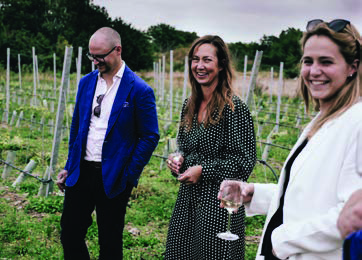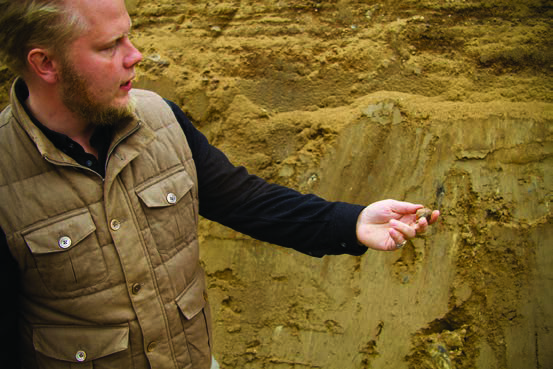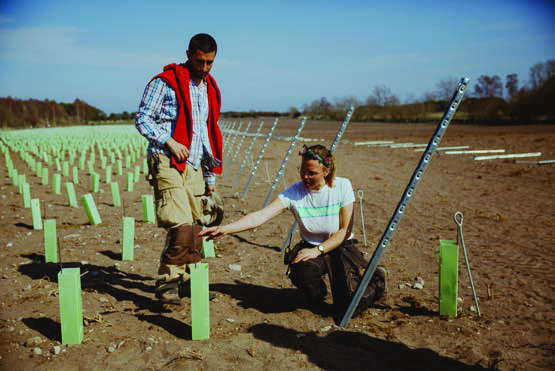This article originally appeared in the Fall/Winter 2022-2023 print issue of Quench Magazine.
Yes, you read that right.
Say Sweden, and most people think of ABBA, IKEA, or Volvo. Wine production not so much – but that might change soon. Meet the people and foreign winemakers who want to put Sweden on the world´s wine map.

K Felix G Åhrberg from Kullabergs winery in the region of Scania 
Andrea Guerra and Emma Serneer från Långmyre winery on the island of Gotland
“We wanted to start a winery up north to avoid problems with climate change, but honestly, we did not think it would be as far north as in Sweden,” says Andrea Guerra.
Guerra is an Italian winemaker from Salerno. After working in wineries around the world, he ended up in Tuscany, where he met his Swedish girlfriend, Emma.
“One day Emma said, almost by a joke, why don’t we start a winery at the Island of Gotland where we have our summer home,” Guerra continues.
The idea seemed crazy, but they started to study the soil and the climate and were surprised by the data they collected. Emma and Andrea understood that their dream could come true – in Sweden.
“The Island of Gotland outside Sweden´s eastern coast has the most sun hours in the country,” explains Guerra. ”A constant wind from the sea and the soil has a high level of chalk, not different from the soil in Chablis or Champagne.”
During the spring of 2018, the winery Lång-myre was born. Andrea and Emma planted 26.000 vines on five hectares, approximately 12.3 acres. “In a couple of years, we will be able to make around 20,000 bottles,” says Andrea.
The varieties are so-called PIWI varieties, or hybrids, produced by the nursery Vivai Rauscedo in the north of Italy. For example, Fleurtai, a crossing of Tocai Friulano and Sauvignon Kretos originating from Sauvignon Blanc.
PIWI varieties are crossings with traditional grapes (vitis vinifera) and wild vines, making them both resistant to many diseases and adaptable to the Nordic climate. But why use hybrids if the climate is changing? Why not use vitis vinifera like they have done in England us-ing Pinot Noir and Chardonnay?
“Why not?,” answers Guerra rhetorically. He then adds “We live at the winery, and the hybrid varieties require no chemical treatment. Therefore the agriculture is naturally environmentally friendly and sustainable – all without compromising the quality.”
K Felix G Åhrberg from the winery Kullabergs agrees. “Why use a Fiat when you can have a Ferrari,” he says while showing the new and impressive 2000 square meter size winery under construction. Åhrberg grows many different hybrids, as well as the most common hybrid in Sweden, Solaris. With Solaris he makes one of the most appreciated wines from Sweden, Immelen, a rich white wine with tropical fruit aromas, buttery texture and a fresh finish.
Kullabergs is in the western Scania, the most southern region in Sweden. The stunning area has high cliffs overlooking the sea, picturesque villages, and beautiful hiking paths.
Åhrberg is one of the leading figures behind the Swedish wine scene. An enologist, viticulturist and pomologist educated in Austria, with experience also from Italy, France, Switzerland, South Africa, and New Zealand (he almost counts as a foreigner), Åhrberg is trying to take Swedish wine production one step further. He has a leading role in creating the first rules for wine production, as well as the upcoming first Swedish PDOs (Protected Designation of Origin) and PGIs (Protected Geographical Indication), something that does not exist yet in Sweden.
“The document is being controlled by the authorities now and will hopefully be approved before this harvest,” Åhrberg explains.
Kullabergs has 14 hectares (30.8 acres) with vineyards. Several foreign winemakers are working in the field and the cellar, including Nicola d´Agostini from Italy.
“I came here after seeing an announcement on Facebook and thought, why not? ” d´Agostini says.
He thinks it is fascinating and, at the same time, challenging to work in such a young wine country. Swedish wine production started in 1999, and today there are around 150 hectares in total and 20 serious producers who are not seeing wine production only as a hobby. Most vineyards are in southern Sweden and on the Islands of Öland and Gotland.
“I think it will take time to find an identity,” d´Agostini muses. “Today many Swedish wines are forced to be something they are not. I mean too much use of wood, too ripe and too similar to wines from New Zealand or France. It is difficult not to try to copy something that already exists.” Like everyone interviewed, he thinks sparkling wines will be the future, together with vertical and mineral whites and rosé wines.
Another winery in Scania is called Thora, owned by Johan and Heather Öberg. Here, two young French winemakers take care of the facility. Emma Berto grew up in a Swedish and French family in Avignon, France. She studied oenology and viticulture at the University of Montpellier and worked with prestigious domaines like Beaucastel and Chateau Sixtine in Châteauneuf-du-Pape. At the university, she met Romain Chichery, a French winemaker specialising in biodynamic viticulture.

They are not sure that the PIWI varieties are the future for Sweden. In fact, at the winery, they have traditional Pinot Noir.
“Hybrids give good grapes, but it is hard to control the maturation,” Berto notes. “Most PI-WIs have big leaves, which result in intense photosynthesis and accumulate a lot of sugar. It is hard to find a balance.”
Chichery thinks it is vital for a new wine country to have a long-term strategy, and it might not be suitable to focus only on hybrids.
“Maybe in five-ten years, the PIWI varieties will be sensitive to new diseases or mildews, and then they will make no sense,” he says. “I would not take the easiest way.”
They have noticed that the vines with Pinot Noir are doing well.
“Our vineyards are only 500 metres from the sea and exposed to a lot of wind,” Berto says. “The wind brings sea salt that helps to dry the atmosphere and reduce the impact of fungus. We sprayed the same amount of sulphur on Pinot Noir as on our Solaris. We are not allowed to spray the vines with copper in Sweden; that is forbidden.”

Another challenge compared to their previous experiences around France and Germany is handling the vineyard. “We have a short growing season in Sweden, with intense sunlight during summer,” Berto continues. “The cycle of the vine is different from the ones on the continent. It is a big challenge during summer, the vines grow quickly, and the photosynthesis is strong, so we are still learning to find a good balance in this new growing environment.”
The route to market for Swedish wine is another challenge. Direct sales from the wineries is forbidden by law, and the State Monopoly, Systembolaget, regulates the Swedish market. It is possible to find some Swedish wines in the local monopoly stores; otherwise, the only way to try them is in Swedish restaurants or at the wineries.
“The cost for production is high, so the prices start from 20 euro a bottle,” Berto points out. “It is expensive for what you get. We must make a larger quantity of higher quality in the future – we will get there, I am sure.”
Perhaps when thinking of Sweden in the future, we might need to add Swedish wine to the list with ABBA, IKEA, and Volvo.
Åsa Johansson came to Italy from Sweden in 2001 because she loved Italian films from the ‘50s and ‘60s and wanted to learn Italian. It was love at first sight. Following a degree in political science and journalism at the University of Florence, she now writes about wine, food, and travel for Swedish, Norwegian, Italian and Canadian publications. Asa travels back to Sweden on a regular basis to hold courses and seminars on Italian wines. Since 2019 she produces her own extra virgin olive oil, La Collina Blu, from the olive trees on the Tuscan hills where she lives with her husband Stefano and two children. Her latest project is Sweden’s first podcast about Italian wine.


